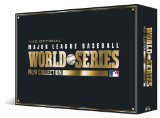| Reviews & Columns |
|
Reviews DVD TV on DVD Blu-ray 4K UHD International DVDs In Theaters Reviews by Studio Video Games Features Collector Series DVDs Easter Egg Database Interviews DVD Talk Radio Feature Articles Columns Anime Talk DVD Savant Horror DVDs The M.O.D. Squad Art House HD Talk Silent DVD
|
DVD Talk Forum |
|
|
| Resources |
|
DVD Price Search Customer Service #'s RCE Info Links |
|
Columns
|
|
|
Official World Series Film Collection, The
The Mostly-Modern History of the World Series
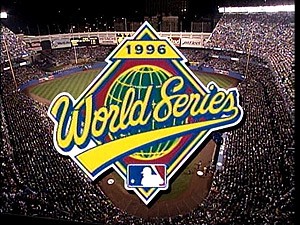 Reviewer's Bias*
Reviewer's Bias*
Loves: Yankees
Likes: Baseball
Dislikes: Sports being too serious
Hates: Red Sox
The Show
I'm a fan of the Yankees, to be certain, a lesson learned from my grandfather, an old-school baseball man. I definitely enjoy catching Long Island Ducks games, where they've struck a perfect balance between minor-league ball and big-league feel. But, as for the game of baseball itself, I'm merely an admirer, as my heart belongs to hockey. I'm a fan of hard work and action, and no sport compares to the coolest game on ice, especially baseball, a game that's excessively long and involves a lot of standing around. It's the only one of the big four where you can play a double-header, which says it all.
Now, if you cut down on all the standing around and mound conferences, and slice the amount of games played (162 games? Seriously?) then you've really got something. That's why these World Series films may be the perfect representation of the supposed national pastime. Compressing the meaning and excitement of an entire season into about an hour cuts all the fat and leaves you with the memories, storylines and big plays that make each championship worth remembering.
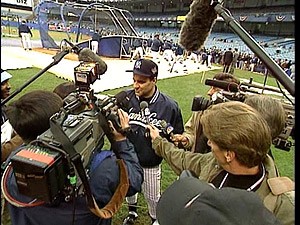 Of course, that's not the reason these movies exist. When they first started, as humble half-hour black and white wrap-ups in the vein of SportsCenter, they were the only chance for the boys fighting overseas to know what was happening back home in the big leagues. They had the look and feel of newsreels, with the traditional boisterous, newsy voice-over, a mix of posed swings and pitches mixed with mostly silent gameplay and crowd footage to tell the on-field story and a pinch of "for the boys" jingoism. As a curiosity from time long past, the films of this era are interesting, but like the aforementioned ESPN highlights, they all tend to blur together, marked mainly by the chance to see some of the legends, like Jackie Robinson and Bob Feller, or a retired Babe Ruth taking in a game at The House he Built.
Of course, that's not the reason these movies exist. When they first started, as humble half-hour black and white wrap-ups in the vein of SportsCenter, they were the only chance for the boys fighting overseas to know what was happening back home in the big leagues. They had the look and feel of newsreels, with the traditional boisterous, newsy voice-over, a mix of posed swings and pitches mixed with mostly silent gameplay and crowd footage to tell the on-field story and a pinch of "for the boys" jingoism. As a curiosity from time long past, the films of this era are interesting, but like the aforementioned ESPN highlights, they all tend to blur together, marked mainly by the chance to see some of the legends, like Jackie Robinson and Bob Feller, or a retired Babe Ruth taking in a game at The House he Built.
The change from black and white to old-school color film, in 1958, was accompanied by a change that removed a lot of the off-field stuff, and focused on the games, moving simply from big play to impressive highlight as each series progressed. While it's great to see extensive footage of players like Carl Yastrzemski and Roberto Clemente (which helps a viewer find new respect for legends of long ago) and the occasional behind-the-scenes gem (one pre-game umpire meeting where they go over just about every possible ground rule is bizarrely intriguing) that's hardly the only reason to watch these films.
The over-the-top product placement, including plugs for sponsors like Coca-Cola and United, are fun to watch for, as are the fashions of the time, whether it's the overly formal clothing of the '40s, '50s and '60s, or the gawdawful clothes of the '70s, '80s or '90s. You also get to hear from some of the game's most memorable voices, including Mel Allen, Vin Scully, Harry Caray (before he became a cartoon,) Bob Costas and Al Michaels, as well as a man whose voice was sports' voice, Curt Gowdy. But there's also some questionable decisions in the '60s and '70s, like the awkward recreations of mound conversations, done with only the coach speaking (while sounding like reading) or the use of barbershop quartet music to score the action. Eventually the elements start to come together, like the introduction of true game sound and on-field mics (smartly provided to Tommy Lasorda) in 1972 and locker-room footage in 1979, to give a better picture of the game.
In the end though, it's the games that are the reason you're watching. Because of that, these films can drags. Starting at a half-hour in the early days to a peak of 98 minutes for the 2002 series between the Angels and Giants, the films get bogged down in the games, which is odd to say, since these aren't game films. They are about the championship. By comparison, the America's Game series, which document the winners of the Super Bowl, barely shows game play, focusing on the season as a whole for the winning team, the players and what it took to win. The result is a series that's eminently more entertaining, though in the past decade or so, including the glorious victories of the New York Yankees and the 2004 tale of Boston's drug-fueled path to ruining their rep as lovable losers, the MLB films have turned toward telling an engaging story via interviews and better structure. The narration gets a boost from some big names also, bringing voices like Beantowners Dennis Leary and Matt Damon, along with Michael Clarke Duncan, Terrance Howard and Billy Bob Thornton to the mic.
Naturally, as a Yankees fan, I'm going to gravitate to any of the 26 films dedicated to my franchise's unprecedented success, but there are plenty of excellent fims to check out, including the 2007 Red Sox film (I may hate the Sawks, but it's a well-made retrospective), the 1989 story of the Bay Area Series affected by an earthquake (with footage from the scene) and the 1979 Pittsburgh/Baltimore match-up, a seven-game series marked by the characters on each side. The only ones you might want to skip are the early '90s, or at least skip the final 10 minutes or so, as they pull out a mawkish ballad to lend the series meaning, in theory, but it's just pathetic in practice.
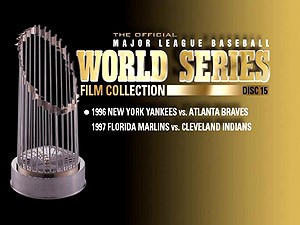 The DVD
The DVD
The 50 hours of World Series films are spread over 20 DVDs, which are packaged in a beautiful hardbound book (more on this later,) with cardboard sleeves built in to hold the discs, a set-up sure to infuriate some collectors. Slide the book out of its sturdy slipcase, and you can admire the classy, understated design of the book, which includes empty spaces for the 2009 Yankees and whatever team follows them in the history books. The best compliment one could pay this packaging is the fact that baseball fans might want to own it even without the DVDs.
The discs feature static, full-frame menus, offering the choice of films on each DVD. There are no audio options, no subtitles and no closed captioning.
The Quality
The quality of these films is all over the road, as you've got years with good film and some with bad, some with brutally noisy video, others coming off crisp and beautiful. Up until 1997, the films are presented full-frame, though 1997 is oddly pillar-boxed, and there's nothing introduced to the archival footage as far as digital problems are concerned, but you'll find plenty of instances of dirt and grain in the early film, giving way to harsh, noise-filled video, before moving on to the beauty of the late-90s series. Overall, the best way to put it is to say it's just what you'd expect for a collection of over six-decades of films that have been cared for, but not remastered.
Aurally, this set is as vanilla as you can get, delivering the films' mix of narration, game sound and terlevision coverage in simple, center-balanced Dolby Digital 2.0 tracks that get the job done of providing clear sound and nothing more.
The Extras
This set's about the films and only the films, offering nothing in the way of extras on the discs.The book is an excellent addition though and will look terrrific on a bookshelf. Featuring a mix of glossy, high-end paper pages and thicker foam-core sleeves, the book offers up beautiful photos and notes about some of the biggest moments in the history of the Fall Classic, though oddly doesn't cover every series (outside of the results listings for the full Series' history from 1903-2008.) The book gets started with an enjoyable forward by Bob Costas, who's heard frequently in the latter third of the set.
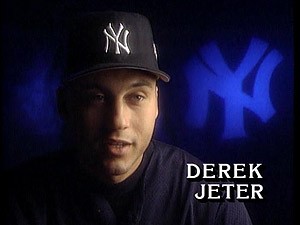 The Bottom Line
The Bottom Line
For a baseball fan, someone who'll watch a game no matter who's playing, this is a tremendous set, like the best 50-hour episode of SportsCenter ever, with enough bonus retro-awful elements to have a good time watching with friends. There's not much in the way of bells and whistles in the set, outside of the beautiful packaging, so you have to care about all the baseball that's documented. If you do though, you couldn't ask for much more.
Francis Rizzo III is a native Long Islander, where he works in academia. In his spare time, he enjoys watching hockey, writing and spending time with his wife, daughter and puppy.Follow him on Twitter
*The Reviewer's Bias section is an attempt to help readers use the review to its best effect. By knowing where the reviewer's biases lie on the film's subject matter, one can read the review with the right mindset.
|
| Popular Reviews |
| Sponsored Links |
|
|
| Sponsored Links |
|
|
| Release List | Reviews | Shop | Newsletter | Forum | DVD Giveaways | Blu-Ray | Advertise |
|
Copyright 2024 DVDTalk.com All Rights Reserved. Legal Info, Privacy Policy, Terms of Use,
Manage Preferences,
Your Privacy Choices | |||||||









